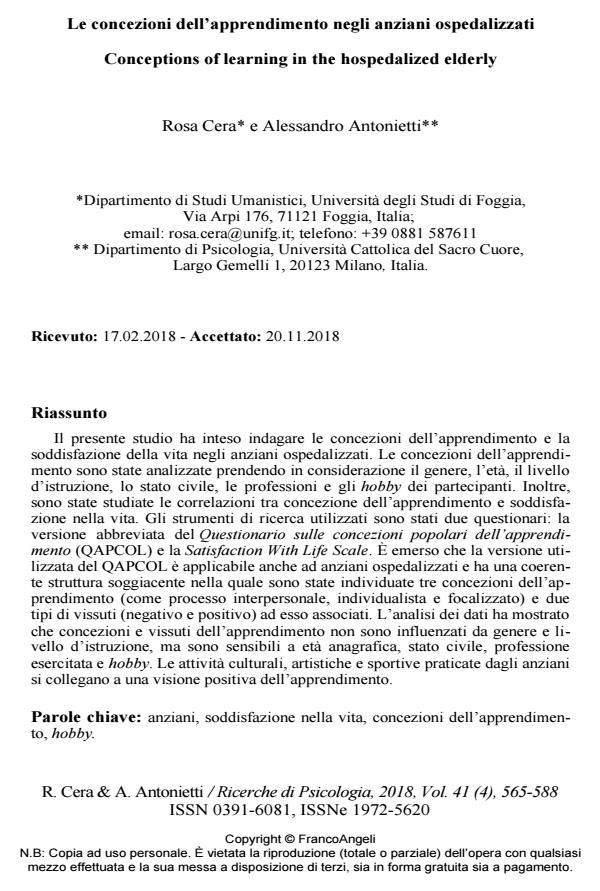Le concezioni dell’apprendimento negli anziani ospedalizzati
Titolo Rivista RICERCHE DI PSICOLOGIA
Autori/Curatori Rosa Cera, Alessandro Antonietti
Anno di pubblicazione 2019 Fascicolo 2018/4
Lingua Italiano Numero pagine 23 P. 565-587 Dimensione file 238 KB
DOI 10.3280/RIP2018-004002
Il DOI è il codice a barre della proprietà intellettuale: per saperne di più
clicca qui
Qui sotto puoi vedere in anteprima la prima pagina di questo articolo.
Se questo articolo ti interessa, lo puoi acquistare (e scaricare in formato pdf) seguendo le facili indicazioni per acquistare il download credit. Acquista Download Credits per scaricare questo Articolo in formato PDF

FrancoAngeli è membro della Publishers International Linking Association, Inc (PILA)associazione indipendente e non profit per facilitare (attraverso i servizi tecnologici implementati da CrossRef.org) l’accesso degli studiosi ai contenuti digitali nelle pubblicazioni professionali e scientifiche
Il presente studio ha inteso indagare le concezioni dell’apprendimento e la soddisfazione della vita negli anziani ospedalizzati. Le concezioni dell’apprendimento sono state analizzate prendendo in considerazione il genere, l’età, il livello d’istruzione, lo stato civile, le professioni e gli hobby dei partecipanti. Inoltre, sono state studiate le correlazioni tra concezione dell’apprendimento e soddisfazione nella vita. Gli strumenti di ricerca utilizzati sono stati due questionari: la versione abbreviata del Questionario sulle concezioni popolari dell’apprendimento (QAPCOL) e la Satisfaction With Life Scale. È emerso che la versione utilizzata del QAPCOL è applicabile anche ad anziani ospedalizzati e ha una coerente struttura soggiacente nella quale sono state individuate tre concezioni dell’apprendimento (come processo interpersonale, individualista e focalizzato) e due tipi di vissuti (negativo e positivo) ad esso associati. L’analisi dei dati ha mostrato che concezioni e vissuti dell’apprendimento non sono influenzati da genere e livello d’istruzione, ma sono sensibili a età anagrafica, stato civile, professione esercitata e hobby. Le attività culturali, artistiche e sportive praticate dagli anziani si collegano a una visione positiva dell’apprendimento.
Parole chiave:Anziani, soddisfazione nella vita, concezioni dell’apprendimento, hobby.
Rosa Cera, Alessandro Antonietti, Le concezioni dell’apprendimento negli anziani ospedalizzati in "RICERCHE DI PSICOLOGIA " 4/2018, pp 565-587, DOI: 10.3280/RIP2018-004002